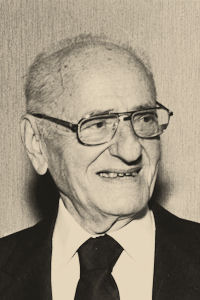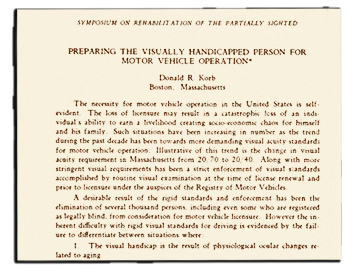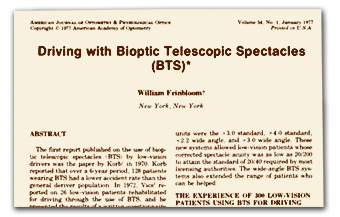Bioptic Driving: A Historical View
"Each failure taught me a new need and was nurtured in my unconscious until somehow it gave birth to a new development."
- William Feinbloom, O.D., Ph.D. 1904-1985
Low Vision Pioneer, Inventor & thePioneer in Bioptic Driving
This history will continue to change as more and more information is submitted. We are happy to consider information from others involved in the early years of bioptic driving. Submit information to richw@eyeassociates.com.
The Early Developments
In 1915 the Kaiserliches Patentamt, the Germany patent authority, granted Alexander Simon from Halberstadt a patent for the design of a bioptic system. A bioptic system has a telescopic system mounted within a spectacle correction so that the patient can access both a general prescription and the telescope. A more modern design was patented in Germany in 1953. The literature, however, fails to show if the design was used successfully. (Source Internet article Randy Jose, O.D.)
Simon A Fernbrille. Patentschrift von Kaiserliches Patentamt nr 302387, klasse 42h. gruppe26. (1917).
 William Feinbloom, OD, Ph.D.
William Feinbloom, OD, Ph.D.
Dr. William Feinbloom pioneered the field of optometric low vision rehabilitation in the United States. In 1932, at age 28 while examining a visually impaired patient he became frustrated that he had no methods to help this elderly gentleman.
He used an astronomers telescope as a model to design a small 3X power telescope, which was small enough that he could mount it in a spectacle frame. This restored the man’s functional vision. This case became the catalyst for his pioneering life work in low vision care.
The Bioptic System Introduced in the USA
In 1958 he introduced to the USA, the concept of a bioptic telescopic system (BTS) that combined a prescription eyewear lens with a small Galilian telescopic system mounted within. He was the first to present the idea of bioptic driving at a session on Contact Lenses and Subnormal Vision at the American Academy of Optometry meeting in December of 1958.
Feinbloom W. The training and after care of the partially blind patient. Journal of the American Optometric Association, 1958; 29:724.
In 1961, Feinbloom founded Designs for Vision, a company that produced his many innovations including surgical and dental telescopes based on his bioptic concept. These are used today by doctors throughout the world.
The Concept of Bioptic Driving
Feinbloom and Korb Lead the Way
Feinbloom's bioptic system allowed the patient to easily change view from the telescope to the general prescription. This became the breakthro ugh that would eventually lead to bioptic driving. After introducing the concept of bioptic driving Dr. Feinbloom worked over the next two decades to educate doctors on how his invention could help many mildly visually impaired patients drive.
The first scientific study published on the  use of bioptic telescop es for low-vision drivers was by Dr. Donald Korb in 1969. Dr.Korb had done a brief informal intership in Dr. Feinbloom's practice which spurred his interst in this area. Dr. Korb not only performed the study but also worked with the Massachusetts driver licensing authority to obtain provisional licenses for these patients.
use of bioptic telescop es for low-vision drivers was by Dr. Donald Korb in 1969. Dr.Korb had done a brief informal intership in Dr. Feinbloom's practice which spurred his interst in this area. Dr. Korb not only performed the study but also worked with the Massachusetts driver licensing authority to obtain provisional licenses for these patients.
Korb DR. Preparing the visually handicapped person for motor vehicle operation. American Journal of Optometry & Archives of American Academy of Optometry, 1970; 47(8):619-28.
 In 1977 Feinbloom presented results from a study of 300 bioptic drivers, which showed no accidents causing bodily injury or significant property damage.
In 1977 Feinbloom presented results from a study of 300 bioptic drivers, which showed no accidents causing bodily injury or significant property damage.
Feinbloom W. Driving with Bioptic telescopic spectacles. American Journal of Optometry & Physiological Optics, 1977; 54(1): 35-42.
Dr. Feinbloom continued to develop new forms of bioptic systems. His Wide Angle 2.2X and 3.0X bioptics became the mainstay of bioptic fitting for these early years and still today are used frequently.
Later in life when he developed macular degeneration, he reported he could use his new personal vision problem to better understand the problems of his patients. He continued to design telescopic systems, low-vision microscopes, and other visual aids until his death in 1985 at age 81. Today he is considered the “father” of low vision optometry in the United States.
The Legalization of Bioptic Driving
During the 1970s and 1980s, bioptic driving emerged as a viable option to aid a select group of mildly visually impaired individuals to continue as licensed drivers. California began issuing bioptic driver’s licenses in 1971.
The first California patient was Dennis Kelleher, a graduate student at University of California at Berkley. He was was fit by Dr. Edwin Mehr and received his license on March 8, 1971. Dennis Kelleher tells his story of becoming the bioptic driver in our section on pioneers in bioptic driving. Dennis reports that he was given the article that Dr. Korb had just published and was incourgaged to proceed after calling and speaking with Dr. Korb.
On May 1, 1977, New York adopted new laws allowing for bioptic driving.
During the 1970s, Korb, Jose and Butler published articles that laid the framework for training the bioptic driver.
Jose RT and Butler JH. Driver's training for partially sighted persons: An interdisciplinary approach. New Outlook for the Blind, 1975; 69(7):305-11.
Jose RT and Butler JH. Training a patient to drive with telescopic lenses. American Journal of Optometry & Physiological Optics, 1975; 52(5):343-6.
In 1984, the Department of Transportation issued a statement that indicated the visually impaired individuals should not be discriminated against. DOT’s action, though of limited power, did lead more states to look at the option of bioptic driving.
In 1984 Dennis Kelleher, the first licensed bioptic driver in California, published an important account of his personal experience with bioptic driving.
More programs emerge across the United States
The Indiana Model Program
In the 1980s, members of Indiana Low Vision Rehabilitation Society including Richard Windsor,O.D. Indiana driving rehabilitation specialists and the Indiana BMV came together to develop a model process to license bioptic drivers in Indiana.
They developed vision requirements for safe bioptic driving and outlined a process that emphasized extensive behind-the-wheel with a driving rehabilitation specialist. In 1986, the Indiana Bureau of Motor Vehicles adopted these guidelines for bioptic driving. The rules adopted have become a model program for bioptic driving acoss the United States. The success of the Indiana program is due to the extensive behind-the-wheel training and the many checks and balances as a patient goes through the process.
Today 39 states have adopted some form of bioptic driving licensure. Unfortunately not all have established training requirements.
Michigan and the Beaumont Hospital Model
In 1986 Michigan also began a program for visually impaired. In 1992 William Parks, O. D., Andrea Herbert, O.T.R. and Julie Untain, M.S. published A driving program for the visually impaired in the Journal of the American Optometric Association. A comprehensive program of diagnostic testing and training was presented. It was based on their work in Michigan at the Low Vision Service at Beaumont Eye Institute, William Beaumont Hospital. The program presented would also severe as an important model in the development of comprehensive bioptic driving programs.
O. D., Andrea Herbert, O.T.R. and Julie Untain, M.S. published A driving program for the visually impaired in the Journal of the American Optometric Association. A comprehensive program of diagnostic testing and training was presented. It was based on their work in Michigan at the Low Vision Service at Beaumont Eye Institute, William Beaumont Hospital. The program presented would also severe as an important model in the development of comprehensive bioptic driving programs.
The Emergence of Keplerian Bioptics
In the 1984, Ocutech was founded. The innovators at Ocutech began work on developing the Visual Enhancement System (VES), a new type of monocular bioptic based on Keplerian telescopic optics. Dr J. Pekar who himself is visually impaired had developed and patented the original VES design. This system had a wider field of view than previous Galilian bioptics and was found more cosmetically acceptable than many traditional bioptic systems. Tubes were no longer extending outward from the lenses. The VES system was developed with a grant support totaling over $1.5 million from the National Eye Institute (NIH) and the Ontario (Canada) Ministry of Health,
In 1996, Ocutech created the first autofocusing bioptic system. The VES- AutoFocus (VES-AF) development project took over 6 years and almost $1 million to complete. The Ocutech VES has emerged as an excellent and well-accepted bioptic system for driving. Ocutech bioptic systems emerged as an important system for driving. The latest version, the VES Sport has continued to improve on the initial VES design.
Designs for Vision would soon also develop a line of Keplerian bioptics.
The Beecher Mirage
From Bird Watching to Bioptic Driving
The Beecher Mirage is a type of lightweight binocular that has been used by many low vision patients. Many patients wear the system for bioptic driving owing to the outstanding Keplerian optics. Two individual from outside the ophthalmic community are responsible for its development William Beecher, Ph.D., orinithologist and 25 year director of the Chicago Academy of Science and Fred Mitchell, an expert in plastic molding.
The excellent Keplerian optics of the Beecher Miage lead to it soon being adapted for bioptic driving. The 5.5X Beecher Mirage offered a binocular system that provided a very wide bright field of view for patients for whom other traditionally used 4X power bioptics were not enough magnification. In Indiana we sought and received approval to begin use of the 5.5X system because of the quality of the optics and wide field.
Beecher Research originally offered a rimless mount of a carrier lens that could be fabricated around each eyepiece. This worked but the protection it provided in an airbag depolyment was questionable. We began mounting the system over the top of a separate carrier pair of eyeglasses. Usually one clear prescription and one sun prescription. Both were made with polycarbonate for added protection. We modify the nose piece and its postion to rest on the nose bar of the frame. The Behenke modification, a small angled washer adjust the angle up of the telescope to a position that allows the telescopes to be straight ahead when looking down the road.
References
Our thanks go out to Donald Korb, O,D, Randy Jose, O.D., Dennis Kellehar Ed.D., the family of William Feinbloom O.D., Ph.D., and Carol Mitchell, wife of the late Fred Mitchell.
Note: This is an evolving history, we welcome other patients and clinicians to send their comments or ideas to richw@eyeassociates.com. We will continue to add and edit this document.
The Low Vision Centers of Indiana
Richard L. Windsor O.D., F.A.A.O., D.P.N.A.P.
Craig Allen Ford O.D., F.A.A.O.
Laura Kathleen Windsor. O.D., F.A.A.O.
